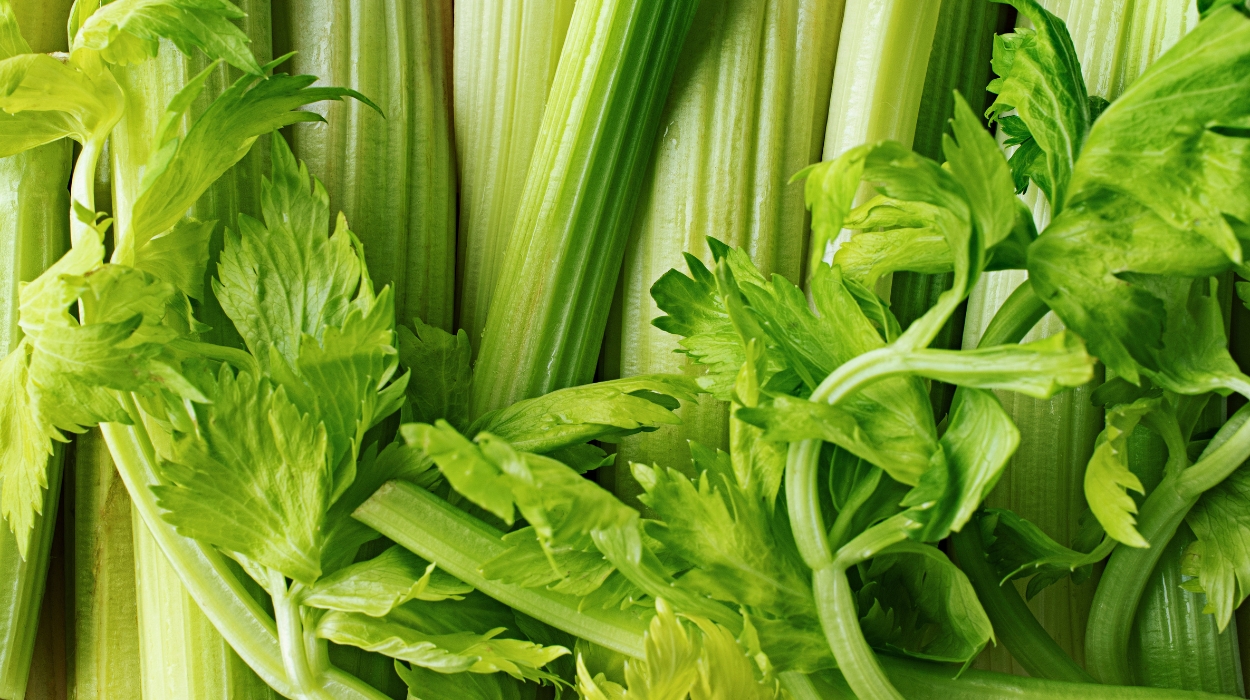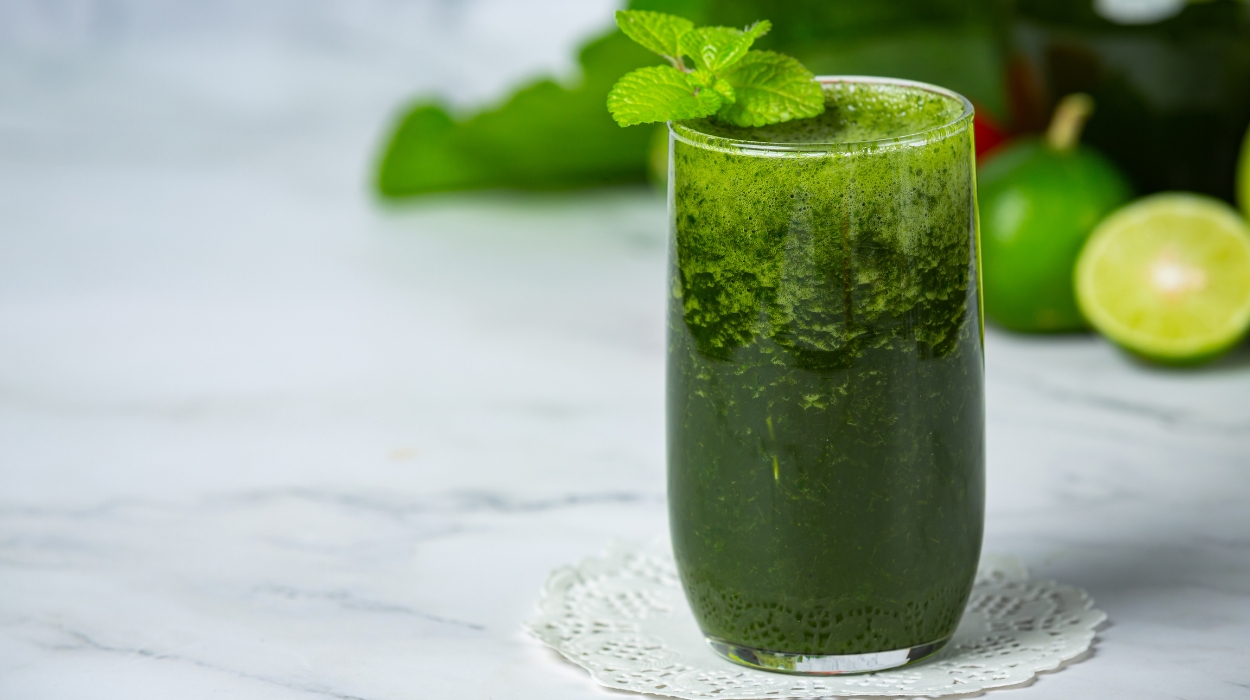 Expert's opinion
Expert's opinion
Expert's opinion
The article is a subjective view on this topic written by writers specializing in medical writing.
It may reflect on a personal journey surrounding struggles with an illness or medical condition, involve product comparisons, diet considerations, or other health-related opinions.
Although the view is entirely that of the writer, it is based on academic experiences and scientific research they have conducted; it is fact-checked by a team of degreed medical experts, and validated by sources attached to the article.
The numbers in parenthesis (1,2,3) will take you to clickable links to related scientific papers.
5 Benefits Of Celery: Nutrition Facts & How To Eat Healthily 2024

Celery is a popular, low-calorie snack loaded with many health benefits. Celery — Apium graveolens L — is part of the apiaceous family and is closely related to carrots, parsnip, and parsley. Although celery has been used in medical practices since ancient times, its hidden superpowers are often overlooked.
Celery is a superfood for many reasons. Celery seeds, leaves, and essential oils all provide numerous health benefits. But what about celery juice? Let’s dive into the many celery benefits and find out why you should include this crispy vegetable in a healthy diet.
Is Celery Good For You?
It’s true; celery is very nutritious and good for you. The health benefits of celery include:
- Reduce Inflammation
- Antibacterial And Antifungal Effects
- Support Digestion
- Protect Cardiovascular Health
- Prevent And Block Cancer
- Prevent Other Diseases
- Skin Benefits
Health Benefits Of Celery
Celery is used in traditional medicine because it is rich in antioxidants,[1] vitamins, and minerals. Compounds like limonene, selinene, furocoumarin glycosides, and vitamins A and vitamin C are some of the most useful. But why is celery good for you? Let us dive into the world of celery and find out.
Reduces Inflammation
An in vivo study shows a celery-rich diet could help reduce inflammation in the body, restoring balance to the immune system.[2] Inflammation is provoked when viruses or bacteria attack the body or from injuries. Inflammation is the body’s first step in healing. However, chronic inflammation[3] is abnormal and is linked to some forms of cancer, as well as conditions like:
- Alzheimer’s.
- Heart disease.
- Rheumatoid arthritis.
- Diabetes.
Antibacterial And Antifungal Effects
Essential oils from celery have antibacterial effects that may be beneficial in treating some common bacterial infections, lung conditions, and skin disorders. Some experimental studies show celery has some antifungal properties[4] as well.
Supports Digestion
Celery is high in fiber, which benefits the digestive system. Dietary fiber is essential for proper digestion and elimination. Fiber helps:
- Control blood sugar levels.
- Maintain a healthy weight.
- Reduce the risk of major cardiovascular diseases.
- Lower cholesterol.
- Prevent hemorrhoids or diverticulitis.
But there are more digestive tract benefits, too. Due to its natural diuretic properties, celery is often a home remedy for bladder, urinary tract, and kidney health issues. The antioxidants in celery reduce inflammation in the gastrointestinal tract as well. Celery also contains thiamine, i.e., vitamin B1, which increases the production of digestive acids in the stomach.
Protects Cardiovascular Health
The diuretic properties of celery extract improve the circulatory system and heart by removing excess fluid from the body. Fluid removal helps lower blood pressure and removes excess cholesterol from the body. Also, the high fiber content[5] prevents cardiovascular disease by lowering LDL and total cholesterol levels. This all makes a healthier, happier cardiovascular system and heart.
Prevents And Blocks Cancer
Celery contains many antioxidant and flavonoid compounds[1] that help trap and neutralize free radicals to prevent cellular damage. Free radicals damage RNA and DNA, causing diseases like cancer and premature aging.
Celery contains luteolin,[6] a flavonoid that helps with cancer prevention. Luteolin is commonly used in traditional Chinese medicine for this reason, as well as to treat high blood pressure and reduce inflammation.
Another flavonoid in celery is apigenin.[7] Studies show apigenin may be helpful as a chemo-preventative agent that prevents cancer from developing. Studies suggest that one-third to one-half of all cancers may be preventable. So, adding foods like celery that have chemo-preventive agents may effectively fight some forms of cancer.
Other Diseases
Scientific evidence[1] shows celery may help prevent jaundice, liver diseases, urinary tract obstructions, gout, and other rheumatic disorders. One study of rats shows some promise in celery treating neurological conditions and brain injuries via its apigenin. Apigenin[8] has properties thought to stimulate the adult brain to regenerate neuronal cells. The list of health benefits from celery just keeps going. These claims, and others, require more study to determine just how beneficial celery can be.
Skin Benefits
Celery is beneficial to your diet, but is celery good for your skin? Because celery is loaded with vitamins A, C, and E, it can help reduce these skin issues:
- Early signs of aging.
- Fine lines and wrinkles.
- Reduce scaring.
Celery is also rich in omega fatty acids that keep your skin looking young and vibrant. Using celery in a face mask or facial scrub can help revitalize and rehydrate your skin as well.
Celery Nutrition Facts

According to the Food and Drug Administration website,[9] the recommended serving size for celery is two medium stalks, or 110 grams, i.e., about 3.88 oz. Here are the nutritional facts per serving of celery. All Daily Values — DV — are based on a 2,000-calorie recommended diet.
- Total Calories: 15.
- Total Fat: 0 grams.
- Total Carbs: 4 grams.
- Protein: 0 grams.
- Sugars: 2 grams.
- Dietary Fiber: 2 grams — 8% DV.
- Sodium: 115 milligrams — 5% DV.
- Potassium: 260 milligrams — 7% DV.
- Vitamin A: 18 micrograms — 10% DV.
- Vitamin C: 2.4 milligrams — 15% DV.
- Calcium: 46 milligrams — 4% DV.
- Iron: 0.25 milligrams — 2% DV.
Celery is mainly made up of water. In fact, about 95% of celery is water. Therefore, make sure to grab some celery this summer to help prevent dehydration. Now let’s talk about the health benefits of celery.
How Much Celery Should You Eat A Day?
While all the benefits of celery aren’t entirely known, the evidence is overwhelmingly in favor of adding it to your diet. When you mix celery with a nutritionally dense diet, you get the most benefits from this tasty vegetable. But since celery is mostly water, it is extremely low in calories. So, overeating celery can lead to nutrient deficiencies. So, how much celery should I eat a day? According to nutritional professionals, you should limit celery to no more than 1 cup of chopped celery, or four stalks, per day for the most health benefits.
How To Add Celery To Your Diet
This crunchy vegetable can be enjoyed in many ways. Diced, cubed, or whole. Steamed celery is also delicious. But for most people, simply adding it to dishes for that crisp, refreshing flavor is essential. If you are wondering how others are eating celery, here are some of the most common ways to eat celery:
- Celery stalks topped with peanut butter or soft cheese.
- Celery sticks in your favorite dip instead of chips.
- Added chopped celery to tuna, chicken salad, or potato salad.
- Mixed into your stir-fry.
- Diced and added to soups or stew.
- Fresh celery blended into smoothies.
Or grab your juicer and a couple of stalks of celery to make a refreshing glass of celery juice. Because of all the health benefits, celery juice has gained popularity in recent years. But is celery juice good for you? Let’s find out.
Why Is Celery Juice Good For You?

Whether you make your own or grab a bottle on the go, celery juice may be the ideal way to eat this healthy vegetable. Although celery juice does have less fiber than eating the vegetable whole, it is still low-calorie. Celery juice is a wonderful way to get the other beneficial nutrients that celery is loaded with. In fact, celery juice may pack more punch than the stalks alone. It is still low in sugar but high in anti-inflammatory compounds and antioxidant-rich. If you want to add vegetables or get more vitamins, celery juice may be just the answer.
Potential Side Effects
Is celery good for you? The simple answer is YES. But here are some side effects of celery you should know about.
- Gastrointestinal issues — due to high fiber content, celery may cause gas, bloating, and soft stools if eaten in excess. Celery juice reduces the fiber content while boosting the health benefits.
- Thyroid issues — due to goitrogens,[10] which impair iodine uptake when eaten in massive quantities raw.
- Skin sensitivity to ultraviolet light — due to a naturally occurring compound called psoralens.[11] Overexposure to the sun can cause a rash that lasts up to a week.
- Pesticide contamination — although celery did not land on the Environmental Working Group’s Dirty Dozen guide for highly contaminated foods, it was not on the Clean Fifteen list either. However, celery can contain a moderate amount of pesticides, so stick to organic celery if possible and always rinse thoroughly before eating.
People taking medications for thyroid function, clotting, and blood pressure should consult their doctor before adding celery juice to their diet. Celery juice may interfere with how these medications work.
The Bottom Line
Whether eating it raw or drinking the delicious juice, celery is loaded with benefits and essential nutrients. Celery is low in calories and sugar but packed with vitamins, minerals, antioxidants, fiber, and much more. So, make sure to consider the many ways celery can help improve your overall health, and remember to grab some on your next grocery run.
+ 11 sources
Health Canal avoids using tertiary references. We have strict sourcing guidelines and rely on peer-reviewed studies, academic researches from medical associations and institutions. To ensure the accuracy of articles in Health Canal, you can read more about the editorial process here
- Wesam Kooti and Nahid Daraei (2017). A Review of the Antioxidant Activity of Celery (Apium graveolens L). Journal of Evidence-Based Complementary & Alternative Medicine, [online] 22(4), pp.1029–1034. doi:https://doi.org/10.1177/2156587217717415.
- Arango, D., Diosa-Toro, M., Rojas-Hernandez, L.S., Cooperstone, J.L., Schwartz, S.J., Mo, X., Jiang, J., Schmittgen, T.D. and Doseff, A.I. (2015). Dietary apigenin reduces LPS‐induced expression of miR‐155 restoring immune balance during inflammation. Molecular Nutrition & Food Research, [online] 59(4), pp.763–772. doi:https://doi.org/10.1002/mnfr.201400705.
- Pahwa, R., Goyal, A. and Ishwarlal Jialal (2023). Chronic Inflammation. [online] Nih.gov. Available at: https://www.ncbi.nlm.nih.gov/books/NBK493173/.
- Journal of Essential Oil Bearing Plants. (2022). Chemical Composition, Antifungal, Antioxidant and Cytotoxic Potential of Apium graveolens L. (Celery) Leaves Essential Oil Collected from Nainital, Uttarakhand. [online] Available at: https://www.tandfonline.com/doi/abs/10.1080/0972060X.2022.2113146.
- Hartley, L., May, M.D., Loveman, E., Colquitt, J.L. and Rees, K. (2016). Dietary fibre for the primary prevention of cardiovascular disease. The Cochrane library, [online] 2016(2). doi:https://doi.org/10.1002/14651858.cd011472.pub2.
- Imran, M., Rauf, A., Tareq Abu-Izneid, Nadeem, M., Mohammad Ali Shariati, Imtiaz Ali Khan, Imran, A., Ilkay Erdogan Orhan, Rizwan, M., Muhammad Atif, Tanweer Aslam Gondal and Mubarak, M.S. (2019). Luteolin, a flavonoid, as an anticancer agent: A review. Biomedicine & Pharmacotherapy, [online] 112, pp.108612–108612. doi:https://doi.org/10.1016/j.biopha.2019.108612.
- Sung, B., Hae Young Chung and Nam Deuk Kim (2016). Role of Apigenin in Cancer Prevention via the Induction of Apoptosis and Autophagy. Journal of cancer prevention, [online] 21(4), pp.216–226. doi:https://doi.org/10.15430/jcp.2016.21.4.216.
- Guo, P., Zhang, B., Zhao, J., Wang, C., Wang, Z., Liu, A. and Du, G. (2022). Medicine-Food Herbs against Alzheimer’s Disease: A Review of Their Traditional Functional Features, Substance Basis, Clinical Practices and Mechanisms of Action. Molecules, [online] 27(3), pp.901–901. doi:https://doi.org/10.3390/molecules27030901.
- Center (2023). Nutrition Information for Raw Vegetables. [online] U.S. Food and Drug Administration. Available at: https://www.fda.gov/food/food-labeling-nutrition/nutrition-information-raw-vegetables.
- Mohammad Bagher Maljaei, Seyedeh Parisa Moosavian, Omid Mirmosayyeb, Mohammad Hossein Rouhani, Iman Namjoo and Asma Bahreini (2019). Effect of celery extract on thyroid function; Is herbal therapy safe in obesity? International Journal of Preventive Medicine, [online] 10(1), pp.55–55. doi:https://doi.org/10.4103/ijpvm.ijpvm_209_17.
- Patrick, G., Parastou Shahzeidi, Mattia, A., Downing, C. and Cognetta, A. (2022). Possible role of psoralen-induced phototoxicity in the development of vitiligo. JAAD Case Reports, [online] 21, pp.23–25. doi:https://doi.org/10.1016/j.jdcr.2021.12.004.



